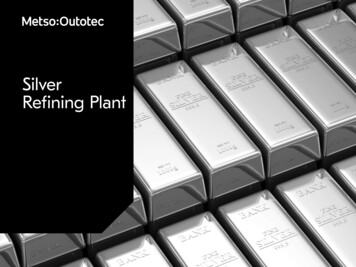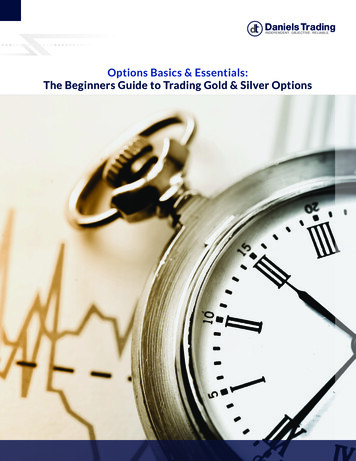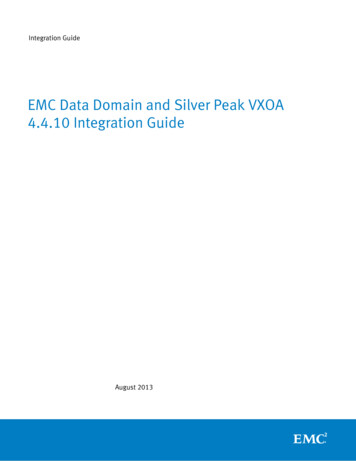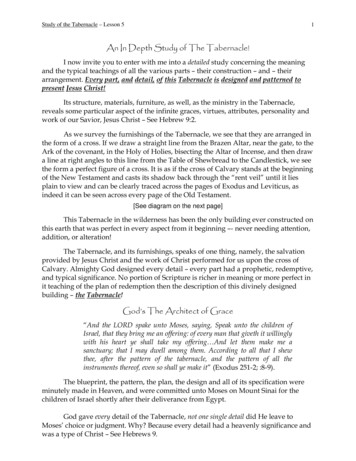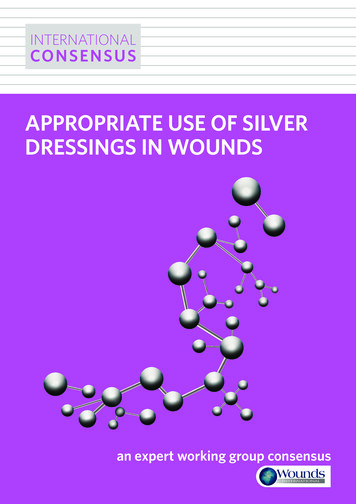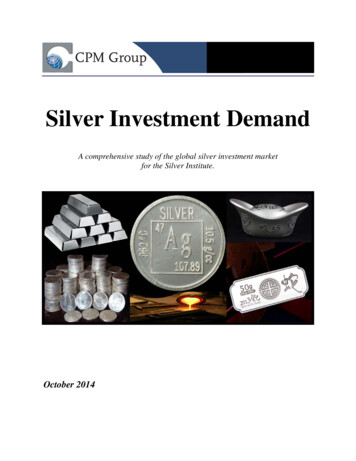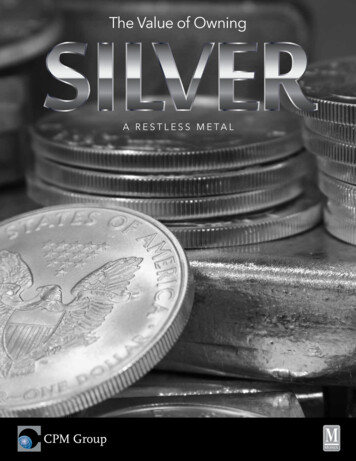
Transcription
The Value of OwningA R E ST L E S S M E TA LMONEX
Copyright CPM Group LLC 2019.These reports are produced by CPM Group for distribution by Monex Deposit Company. The rights to distribution, reproduction, and redistribution rightsare ceded to Monex Deposit Company by CPM Group for these reports. These reports are not for reproduction or retransmission without written consentof Monex Deposit Company. The intellectual content and property of these reports remain the property of CPM Group, and they are not for reproduction orretransmission without written consent of CPM Group. The views expressed within are solely those of CPM Group. Such information has not been verified,nor does CPM make any representation as to its accuracy or completeness. Any statements non-factual in nature constitute only current opinions, which aresubject to change. While every effort has been made to ensure that the accuracy of the material contained in the reports is correct, CPM Group cannot be heldliable for errors or omissions. CPM Group is not soliciting any action based on it. Information contained here should not be relied on as specific investment ormarket timing advice. At times the principals and associates of CPM Group may have long or short positions in some of the markets mentioned here.2
Why Invest In SilverThis report begins with several premises.1Silver has several attributesimportant to investors.2In our view, investors will do wellowning silver in the long run.3If investors treat silver as aninvestment rather than a beliefsystem they will be better off.In order to fully appreciate the values that silver brings to investors,one needs to understand what makes silver compelling to investors.At CPM, we sometimes call silver the “schizophrenic metal.” (Sometimes we say it is “Quadrophrenic,” but that is only meaningful toinvestors of a certain age who liked British rock.) Silver is many thingsat once. It is a/an:t Investmentt Financial assett Form of quasi-moneyt CommodityGold is all of these things too, but it is primarily a financial asset anda form of quasi-money. Gold’s supply and demand have less to withdetermining gold prices than investors buying levels of gold.Silver shares this characteristic with gold, but it is more of a commoditywith greater fabrication and industrial uses than gold. As a result, silver’scommodity nature – its supply and demand trends and conditions – havemore to say about silver prices than do those of gold.3
Multi-faceted“4Silver is alsomuch morethan gold.This multi-faceted nature ofsilver is one of the factorsthat make it so attractive toinvestors. It also is one of thereasons why silver prices aremore volatile than gold prices,and the prices of almost all othermajor commodities. All sorts offactors affect silver prices, including investor attitudes toward theworld around them, technological developments that demandmore silver in electronics, solarpanels, and a range of otherfactors both internal to the silvermarket and external in the worldaround us. (Natural gas pricescompete with silver prices forbeing particularly volatile compared to other commodities, butno one actually buys and storesnatural gas as an investment.They do so with silver.) Thereare other factors that make silverprices more volatile, discussedlater, including the relativelysmall size of the market. Silver isa complement to gold, in manyways, but silver also is muchmore than gold.Silver has been used by investors to store value, to protecttheir assets from a host of threatsand risks, to conduct trade, andto make money through capitalappreciation since the earliestforms of civilization emerged.Silver has been used as atransactional form of moneythroughout most of history.Gold had too high of value tobe used for daily commerce,but silver was not. In the 1800s,as the United States populationexpanded westward there wasno central bank and no centralcurrency that people couldtrust. Currencies were issuedby state-chartered banks, therewas massive counterfeiting, andlocal currencies issued by localbanks. For example currencyfrom Canton, Ohio, might not beaccepted in other parts of thecountry as being legitimate. Asa result, much of the currency incirculation, especially in the frontier districts, was Spanish dollars(pieces of eight) and Mexicanand U.S. silver coins. That was
S ilver Prices S ince 1975Monthly average Comex prices through March 2019 /Ounce45 /Ounce4540403535303025252020151510105575 77 79 81 83 85 87 89 91 93 95 97 99 01 03 05 07 09 11 13 15 17 1910Silver Prices Since 1975not unusual. Much of the currency used in China during itslong run of political instabilityprior to the Communist takeoverin 1949 was U.S., Mexican, andCuban silver coinage. After theCommunist takeover, the silverwas ordered to be turned in. Asrecently as the 1990s, old silvermelted down from such coinagewas still flowing into the Chinesebanking system and silver refineries. The bottom line is: Silverwas money, and it was of a valueand size that made it useful fortransactions around the world.That’s history, but it still appliestoday. Many silver investorsbristle at being called silverinvestors. They call themselvesSilver Stackers, saying they arestacking up silver against thetime when in their views they will(not maybe) need to use silvercoins and bullion as money totransact daily business such asbuying food and fuel. They arein fact investors, in that theyare buying silver as a store ofvalue and a way to preservetheir wealth. They may not bebuying silver expecting capital appreciation, but they seesilver’s investment function asa form of capital appreciationand its monetary function asa means for transacting commerce as still relevant today.They are correct, althoughtoday other factors may seemmore pertinent to silver byother investors. While SilverStackers are buying andholding silver against a futureeconomic catastrophe that maynot occur, most other silverinvestors seem interested inthe metal as a more traditionalinvestment that offers capitalappreciation potential as wellas wealth preservation.See Chart 1 above.“0Prices beingdown from pastcyclical peaksmeans thatprices, in ouropinion, areat pretty goodlevels to stockup and stack upon silver.5
Silver PricesToday’s ‘low’ silver pricesremain roughly double whatthey were throughout the1990s and early 2000s.That brings us to the price of silver. Silverprices right now are low, compared to howhigh they have been during past financialcrises, but high compared to where they havebeen for most of history.The fact that they are higher than in the paston a long-term basis demonstrates thatsilver’s value has increased in the minds ofinvestors, banks, and others, reflecting themore treacherous economic and politicalworld we live in today.Prices being down from past cyclical peaksmeans that prices, in our opinion, are at prettygood levels to stock up and stack up on silver.Here are three historical price charts. Theshorter term chart shows silver prices since2000. Prices have not fallen below 13.70 inthe long decade since the Global FinancialCrisis and Great Recession pushed silveralmost to 50 per ounce. Putting prices inrecent years into perspective: The price hastraded at levels roughly three times theaverage price from the late 1980s untilaround 2006.See Chart 2 on next page.Silver prices have been trading between 15 and 16 for most of the first four monthsof 2019. While silver has a reputation as acommodity with a volatile price, in reality thevolatility of prices has fallen sharply in 2017and 2018. Silver traded between 16.00 and 18.50 from early 2017 through the first halfof 2018. Silver then fell, beginning in July2018, dropped to an intraday low of 13.86last November, before recovering to levelsabove 15 by the start of 2019.Silver prices are at an interesting place rightnow. They are both "low" and high, depending on one’s perspective. There are peoplewho continually lament how "low" silverprices are. Some think the price should be6
around 20. Some are perma-bulls who thinksilver should be 50, 100, or higher. For theforeseeable future, the reality is that silver’ssupply and demand fundamentals likelypreclude prices from ever rising to someof the outrageously high levels the permabulls have been predicting for decades andstaying there. Silver prices can, do, and will inthe future rise sharply, but not to unrealisticlevels some would have us believe.Still, buying today around 15 and takingprofits at 45 or 50 within a decadewould yield a handsome return. The keyis to take your profits when prices are high.Historically, you could buy the silver backat a lower price after the financial scare haspassed. It has happened over and over, andonly a foolish person would think the nexttime is likely to be different. Investors buylow and sell high, and then repeat the cycle.They may hold some of the metal aside asa stacker would, but they also tend to lockin profits and then start buying again whenprices fall.Other silver market observers point out thatwhile silver prices are down sharply fromtheir peaks of 1980 and 2011, they still arehigh at present compared to silver pricesthroughout most of history. This is importantbecause it suggests that silver continues toperform many functions for investors. Yes,silver prices are down from those peaksachieved during times of historically enormous economic, political, and financialmarket turmoil. But they have remained farabove the levels typical of silver in less chaotic times.2Silver Prices Since 2000Real and Nominal Silver Prices /O unce /O unce8080707060605050Real Silver Price404030Nominal Silver Price30202010100360 63 66 69 72 75 78 81 84 87 90 93 96 99 02 05 08 11 14 170Real and Nominal Silver PricesEven when adjusted for inflation, today’s“low” silver prices remain roughly doublewhat they were throughout the 1990sand early 2000s.See Chart 3 to the right.7
Silver In AnInvestmentPortfolioSilver makes sense as a standalone investment. However, itmakes even more sense as partof a diversified portfolio of investments.Adding silver to a portfolio ofstocks and bonds helps smoothout the ups and downs of aninvestor’s total wealth. With someportion of one’s portfolio in silver,as with gold, one could reducethe month-to-month and year-toyear fluctuations of one’s wealth,by smoothing out overall returnsthrough diversifying the basketof assets in which you store yourwealth and seek to profit.Studies of how much silverhistorically might have beenthe optimal proportion of one’sportfolio yields a surprising, if notshocking, result. Between 2016and now, CPM updated our studies of gold and silver’s optimalrole in a diversified portfolio thathad been conducted in the early1980s. The old rubric, developedfrom the early 1980s work, wasthat having gold or silver as 5% 10% of one’s portfolio gave youthe best risk:reward ratio for your“Adding silver to aportfolio may helpsmooth out the upsand downs.8
overall portfolio’s return. That wasbased on the experience from1968 through 1980, the periodduring which gold and silver priceswere truly unbound from U.S. Treasury price management for silverand fixed prices for gold.Updated studies showed thattaking a longer term period ofreview, from 1968 through 2018,the historical results are even morepro-precious metals. The benefitsof having silver in one’s portfoliocontinues up to around 25% ofone’s portfolio. Up to that level,the increases in overall historicalreturns have been greater thanthe increases in overall portfoliovolatility or risk. The optimal levelfor silver appears still to be around5% - 10%: That is the proportionof silver in a portfolio of stocks,U.S. Treasury bills, and silver thatgives one the lowest increase inIn other words: Having 5% 10% of one’s portfolio in silverhistorically has optimized thereturn of one’s portfoliorelative to the risk or%Return10%Portfoliocomposed of S&P, T Bills and 4%16%RiskA Portfolio with 5% Silver is Optimal%CHANGEIN RETURN5See Chart 4 and 5 below.A Portfolio with 5% Silver is Optimal; Silver Benefits up to 25%, 1968-2018RETURNRISK62% SP; 38% TBills, 0%Silver59% SP; 36% TBills, 5% Silver56% SP; 34% TBills, 10% Silver53% SP; 32% TBills, 15% Silver50% SP; 30% TBills, 20% Silver47% SP; 28% TBills, 25% Silver44% SP; 26% TBills, 30% Silver41% SP; 24% TBills, 35% Silver38% SP; 22% TBills, 40% Silver35% SP; 20% TBills, 45% Silver32% SP; 18% TBills,50% Silver29% SP; 16% TBills, 55% Silver26% SP; 14% TBills, 60% Silver23% SP; 12% TBills, 65% Silver20% SP; 10% TBills, 70% Silvervolatility of one’s wealthover time. Having up to25% of one’s portfolio insilver yields better returnswith smaller increases in risk,based on historical data.risks compared to the increase inoverall portfolio returns.%CHANGEIN RISKCHANGE .31%EXPOSURETO ompetitive Portfolilos 1968-20189
Silver Price VolatilityThe fact that silver prices are farmore volatile than those of goldand many other commodities wasmentioned at the beginning ofthis report. In fact, the title refers tosilver as a restless metal, a homageto author and professor Dr. RoyJastram’s book on silver prices,Silver: The Restless Metal.The reality is that silver prices aremore volatile than those of gold.Some people call silver highoctane gold: In bull markets silvertends to out-perform gold, andmany investors like silver becauseit gives them out-sized returnswhen the metals are running.There are many reasons for silver’s greater price volatility. Thefact that many investors buy, hold,use, and sell silver as a form ofmoney contributes to this restlessness. So, too, does the small size“The valueof silvertrading isa smallfractionof gold.uses of silver. Silver is both afinancial asset and an industrialmetal used in a wide range ofmanufactured products.of the silver market. The value ofsilver trading is a small fractionof the value of gold, and almostincalculably small compared tothe size of financial markets suchas stocks, bonds, and foreignexchange trading.Another difference between silverand gold is that some investorsare much more willing to sellsilver when they think prices aregoing to fall than they are willingto sell gold. When investors arebearish on precious metals theytend to buy less gold, but theyhave demonstrated a willingness to sell some of their silver, inthe 1970s and again from 1990through 2005. This two-way flowof investor holdings contributes tosilver’s greater price volatility. So,too, does the greater role industrial, jewelry, and other fabricatedSee Chart 6 below.Silver Price VolitilityMonthly, through March 50%50%40%40%30%30%20%20%10%10%0%777981838587899193 95976 Monthly Silver Price Volitility10One of the interesting aspectsof silver right now is that thevolatility of its prices has fallento very low levels as of 2017 –2019. The last time silver priceswere as calm as they have beenover the past two years was in2000 – 2003, before the bullmarket that started around 2005and took silver to nearly 50 inApril 2011.990103 05070911131517190%
This leads us to where silver is at present. Investors were net sellers ofsilver in those years 2000 – 2004, continuing a long period of dishoardingthat began in 1990. Within a couple of years investors as a group flippedover to being net buyers of silver, as they grew increasingly concernedabout the economic and financial stability of the world, their country, andtheir own banks. Political risks were rising, including increased competitive tensions between the U.S. government and China, increased belligerence between the U.S. government and Russia, and a combination ofwars in Afghanistan and Iraq that were destabilizing international politicsand leading to the steady increase in oil prices from around 10 a barrelat the turn of the decade ultimately to around 143 per barrel in 2008.“Where Silver IsAt Present?Debt loadshave risenwith mostgovernmentsaround theworld.In this environment investors increased the amounts of silver they werebuying and stacking up. As global economic, political and financialconditions worsened they bought more and more silver, driving the pricefrom around 5 per ounce to nearly 50 in six short years.Since 2012 investors have reduced the amount of silver they are buying ona net basis. Prices consequently have fallen back to around 15 per ounce.Chart 6 (next page) shows that in some ways the reduction in silver investment demand and prices from 2012 into 2019 are similar to investmentdemand and price patterns in the late 1980s, which led to a 15 yearperiod of low silver prices and net investor selling.However, we are not in the 1980s.There are far more differences today contrasted to the late 1980s thanthere are similarities. First, the financial, economic, and political imbalances that drive investors to stock up on gold and silver are far worseand worrisome than they were back then. In the late 1980s the U.S.government was racking up annual budget deficits around 350 billion,and had total federal debt around 4 trillion. Now total U.S. government debt is more than 30 trillion and the U.S. is adding more than 1trillion to its debt load every year.It is not just the U.S. government that is astoundingly more profligate nowthan it was then. Debt loads have risen with most governments aroundthe world, with large and medium sized corporations, and with consumers. Pensions were under funded then. They are so much more underfunded today that private pension fund managers admit they have noidea how to catch up.11
International, as well as domestic, political cooperation is gone,compared to what existed in thelate 1980s. International competition has increased. The amountof U.S. dollars floating around theworld is a multiple of what it wasthen. Corporations are movingfrom employing people to buyingcomputers across industries, frommanufacturing to legal firms andinstitutional investment shops.In short, those factors that driveinvestors to buy silver are farmore worrisome now than theywere in the late 1980s. Oneshould expect investors to bemore interested in silver in thenext few years than they were inthe 1990s and early 2000s.But there is another set of factors that are positive for silver.Financial markets have liberalizedand globalized. And they havegone electronic. The amount ofinformation available to investorsabout silver and other investment opportunities has exploded.Investors can read as much asthey desire about silver on theinternet, even as they find theyneed to develop a greater capacity to discern good informationand analysis from bad and biasedinformation.Investors are better informed thanthey were in the late 1980s, andthey have better access to physi-cal silver investments than theydid in the late 1980s.Investors will weigh the pros andcons of holding some of theirwealth in silver and make theirown decisions. As they have inthe past, they most likely willcome to the conclusion that thereis a time to buy more silver, tomove more money out of stocksand bonds into silver and gold.Given the economic and politicalissues facing the world and investors today, they are not likely towait 15 years to start buying moresilver.See Chart 7 below.Silver Market Balance–Net Changes In InventoriesAnnual, Projected Through 2019. Prices through 2018.Million Ounces /Ounce45250Similar Trend In Investment DemandNet Additions402003515030100255020015-50Net Withdrawals-10010NominalPrice (LHS)5071260657075808590Silver Market Balance–Net Changes In Inventories9500051015-150-200
CPM Group LLCCPM Group is a fundamentally based commodities research shop. We develop our own proprietary estimates of gold, silver,platinum, and palladium supply and demand on a global basis, drawing on every resource we can find, including our ownextensive list of contacts involved in precious metals around the world. We have been doing this sort of research and analysissince the 1970s, far longer than anyone else in the business. We also undertake research in specialty metals, base metals, energyand agricultural commodities. We are known for our basic fundamental research, a wide range of financially oriented consulting services, and our expertise in using financial derivatives to structure financing for producers, refiners, industrial users, andinvestors interested in either hedging or investing in commodities.Our investment philosophy is simple: We are value investors who base our decisions on what to buy, sell, hold, or avoid on thefundamentals of each asset, and the macro-economic, financial and political environmental factors that we expect will affectthat asset’s value. We have concerns, expressed in this report and elsewhere, about long-term imbalances in government deficitspending, public and private debt, and a wide range of other economic and political factors. We don’t expect the world’s financial system to collapse, however. That is not the way the world tends to work. More likely economic outcomes in the real worldlie between the extremes of cataclysmic collapses and nirvana. We advise our clients – and practice what we preach – to havesome of their wealth in gold and silver as an insurance policy against a catastrophic failure, but we also advise them to investother portions of their money in precious metals and other assets based on the assumption that that sort of failure does notoccur. We focus on investing based on likely scenarios, but with an eye always open to outlying events that take the world’s markets by surprise. We have watched investors who were so worried about a collapse that they missed some of the largest stockand bond market rallies of all times over the past 30 years, while watching their safe haven assets fluctuate eight-fold in value upand down, and then up and down again. We prefer our clients to buy and sell precious metals and other assets based on cyclicaland other developments, while also maintaining that long-term insurance policy in case the levee breaks.CPM Group LLC168 7th St.Suite 310Brooklyn, NY11215USAT. 1-212-785-8320www.cpmgroup.cominfo@cpmgroup.com13
For more information on precious metals investing and on specific gold,silver, platinum, and palladium investment products, please contact:MONEX DEPOSIT COMPANYMONEX4910 BIRCH STREETNEWPORT BEACH, CA 92660(800) 949-4653www.Monex.com
Silver Stackers, saying they are stacking up silver against the time when in their views they will (not maybe) need to use silver coins and bullion as money to transact daily business such as Prices being down from past cyclical peaks means that prices, in our opinion, are at pretty good le



